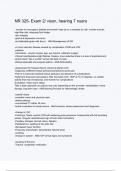NR 325- Exam 2/ vison, hearing 7 nuero
- monitor for neurogenic bladder and bowel- kepe pt on a schedule to cath, monitor sounds,
high fiber diet, adequate fluid intake
-skin integrity
-grief and depression concerns
-set attainable goals with the pt. - ANS-Management of SCI
-A micro-vascular disease caused by complication of DM and HTN
-painless
-risk factors - severe myopia, age, eye trauma, cataracts surgery
-Clinical manifestations-light flashes, floaters, once detaches there is a loss of peripheral and
central vision" like a curtain" across the field of vision
-Retinal specialist and surgical options - ANS-Retinopathy
-Assessment for frequent Neuro checks & altered LOC
-Diagnosis ineffective tissue perfusion(cerebral) & acute pain
-Plan is to improved cerebral rtissue perfusion and absence of complications
Implement Aneurysm precautions- Bed rest quiet room, HOP at 15-10 degrees, no sudden
activity that may increase bp, and monitor for complications
Evaluation- intact neuro status
Take a team approach an options may vary depending on the pt needs- rehabilitation, home
therapy, long term care - ANS-Nursing Process for Hemorrhagic stroke
-careful history
-complete nuero and physical exam
-airway patency
-noncontrast CT within 25 mins
-further evaluation to locate source - ANS-Ischemic stroke assessment and diagnosisi
-change in LOC
-Cushing's Triads- systolic HTN with widening pulse pressures, bradycardia with full bounding
pulses, irregular respirations(a sign of brain stem herniation)
-Pupillary changes, blurred vision, diplopia
-Papilledema ( swelling of the optic disc
-decreased motor function
-Posturing- Decorticate, Decerebrate, flaccid( limp)
-vomiting
-change in speech - ANS-ICP clinical signs and symptoms
-clouding of the lens
-Trauma, congenital, medication
, -Clinical Manifestation- decrease in vision, abnormal color perceptions, glare, blurry vision,
pressure could develop
- nonsurgical and surgical options
Non-surgical or surgical options to fix - ANS-Cataracts
-collection of blood under the dura mater
-usually venus issue - ANS-subdural hematoma
-dependent of size and location
-numbness or weakness of face, arm or leg
-confusion or change in mental status
-trouble speaking or understanding speech
-visual disturbances
-difficulty walking, dizziness or loss of balance
-Motor loss
Hemiparesis- weakness on one side of the body
Hemiplegia- paralysis of one side of the body
-Communication loss
Dysarthria- difficulty forming words
Dysphasia- impaired speech
Aphasia- loss of speech
-Perceptual disturbances
Hemianopsia- loss of 1/2 of visual field
Agnosia- can't recognize familiar objects - ANS-Ischemic Stroke clinical manifestations
-disorder of inner ear causing vertigo, tinnitus, and hearing loss
- Symptoms are fluctuating hearing loss, nausea, vomiting, balance issues, dizziness, fall risk -
ANS-Meniere's disease
-Done for Meningitis, stroke, contraindicated in increase of ICP.
-Ask about anticoagulants may increase risk issues,
-After procedure patient should lay flat, have frequent neuro checks, monitor for infection, or
meningeal irritation
-headache may occur after the procedure - ANS-lumbar puncture
-double vision is main complaint
-unable to focus two eyes simulataneously
In adults it can be related to thyroid disease, nueromuscular problems of eye muscles
- EOM's are what detect it - ANS-Strabismus
-Fluid, produced by ventricles, found within Spinal Cord and in covering surrounding CNS
-Clear and colorless, 100-150 ml of fluid that should stay stable
-NO RBC, minimal WBC but glucose is present - ANS-Cerebral Spinal Fluid (CSF)




